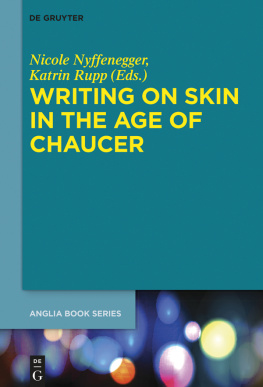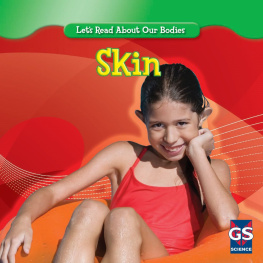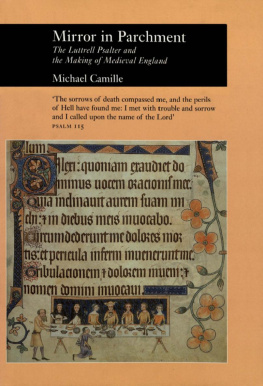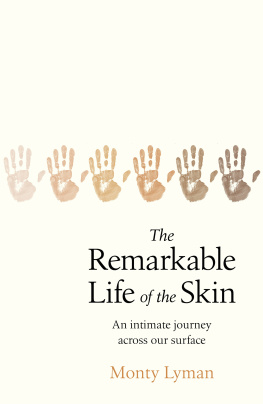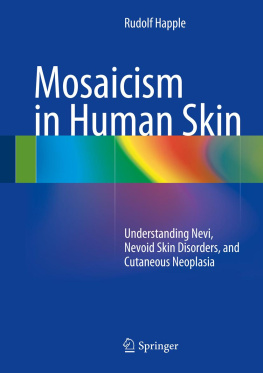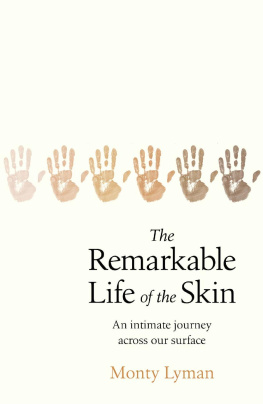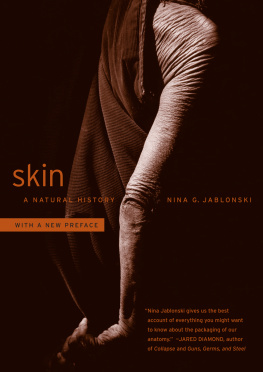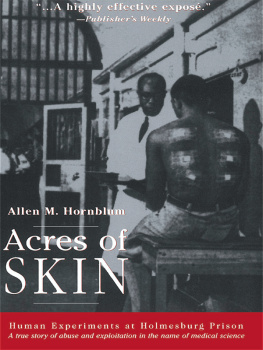Table of Contents
Guide

Writing on Skin in the Age of Chaucer
Buchreihe der ANGLIA/
ANGLIA Book Series

Edited by
Lucia Kornexl, Ursula Lenker, Martin Middeke,
Gabriele Rippl, Hubert Zapf
Advisory Board
Laurel Brinton, Philip Durkin, Olga Fischer, Susan Irvine,
Andrew James Johnston, Christopher A. Jones, Terttu Nevalainen,
Derek Attridge, Elisabeth Bronfen, Ursula K. Heise, Verena Lobsien,
Laura Marcus, J. Hillis Miller, Martin Puchner
Volume 60

For an overview of all books published in this series, please see
http://www.degruyter.com/view/serial/36292
ISBN 978-3-11-057572-9
e-ISBN (PDF) 978-3-11-057813-3
e-ISBN (EPUB) 978-3-11-057587-3
ISSN 0340-5435
Library of Congress Control Number: 2018941014
Bibliographic information published by the Deutsche Nationalbibliothek
The Deutsche Nationalbibliothek lists this publication in the Deutsche Nationalbibliografie;
detailed bibliographic data are available on the Internet at http://dnb.dnb.de.
2018 Walter de Gruyter GmbH, Berlin/Boston
www.degruyter.com
Acknowledgements
We are very grateful to a number of people and institutions without whose generous support this volume would not have been possible. Special thanks go to the contributors of this volume, whose inspiring paper proposals for and stimulating presentations at the New Chaucer Society Nineteenth International Congress in Reykjavk in 2014 provided the starting point for this volume: Sealy Gilles, Michael Leahy, Sharon E. Rhodes, Catherine S. Cox, Erin E. Sweany, Pax Gutierrez-Neal, Roberta Magnani, M.W. Bychowski. Elizabeth Robertsons generous engagement with our project in the afterword is highly appreciated by all of us. We thank our colleagues and friends at our home institutions for their ongoing support: Annette Kern-Sthler, Virginia Richter, Ursula Kluwick, Zo Lehman Imfeld, Kathrin Scheuchzer, Martin Hilpert, Franois Spangenberg, and our students, who keep inspiring us. We thank Lara Portmann for her invaluable copy-editing work, as well as Pauline Bachofner and David Jost for their work on the manuscript at different stages. Thanks are also owed to the Department of English of the University of Bern and the Institute of English Studies of the University of Neuchtel for their financial support, as well as to the UniBern Forschungsstiftung that funded a research stay at the Wellcome Collection in London at a very early stage of this project. We thank the editors of the Anglia Series at De Gruyter, and especially Ursula Lenker and Lucia Kornexl, for including our volume in the series, as well as Ulrike Krauss and Katja Lehming at De Gruyter for their work on the book. We are also grateful to Roberto Fighetti from the Veneranda Fabbrica del Duomo di Milano for his prompt support in obtaining the permission to reproduce the picture of St. Bartholomew included in the introduction of this volume. Nicoles special thanks, as always, go to Rolf, Lucien, Jules, and Michelle Nyffenegger for their patience and generosity. Katrins special thanks go to her parents, Erika Rupp, and Gerhard Blttler for their loving support.
Bern and Neuchtel, June 2018
Nicole Nyffenegger and Katrin Rupp
Nicole Nyffenegger and Katrin Rupp
Introduction:
Writing on Skin in the Age of Chaucer
Adam scriveyn, if ever it thee bifalle
Boece or Troylus for to wryten newe,
Under thy long lokkes thou most have the scalle,
But after my makyng thow wryte more trewe;
So ofte adaye I mot thy werk renewe,
It to correcte and eke to rubbe and scrape,
And al is thorugh thy negligence and rape.
(Chaucers Wordes unto Adam, His Owne Scriveyn)
In his Wordes unto Adam, His Owne Scriveyn Geoffrey Chaucer famously explores the relationship between human skin and parchment. He wishes his scribe Adam to get scabs on his head as a punishment for his careless copying when he writes newe Chaucers works rather than being true to his original makyng of them. This carelessness, in turn, leads to Chaucer having to renewe Adams work. The rubbing and scraping necessary to correct the product of Adams negligence on the parchment resonate suggestively with the rubbing and scraping that would be necessary for poor Adams relief if Chaucers malediction became reality. The continuous palimpsestic renewal and rewriting of each others works in which scribe and poet are engaged here extends to Adams human skin, which is thus presented as an inscribable surface. With Chaucers appropriation of the material side of literary production from his scribe (the rubbing and scraping of the parchment, the rewriting of the poems on it), one wonders whether to picture Chaucer himself bringing quill to parchment for these particular words or to imagine that, in a malicious gesture of dominance, he had his scribe write his own scabs into their literary existence.
This layered text-parchment-skin relation is further complicated by the fact that material and metaphorical uses of skin coexist and arguably intermingle in this poem. This creates an effect of oscillation that medieval readers, used as they were to encountering writing on processed animal skin, may have found easier to disentangle than we do today. Our choice of the phrase writing on skin for the title of this volume reflects this layering. The phrase means both, that human skin is conceived of as inscribable both in the material and in the figurative sense, and that human skin is a topic to write about. Often, the two actually concur: The fact that the marks of leprosy were read as signs of sin inscribed on human skin is only evident to us because medieval authors writing on religion and medicine considered skin a topic worth writing about, as our two opening contributions show. The temporal focus on the age of Chaucer that completes our title allows for a dense synchronic approach to the textuality of human skin in Chaucers works (most prominently the Canterbury Tales ), in works influenced by him (such as Robert Henrysons Testament of Cresseid ), or in works that were influential at his time (such as Guy de Chauliacs Cyrurgie ). This narrow time frame and our focus on English literature allow us to discuss pertinent aspects of the human skins textuality in depth.
What, then, do we understand by the textuality of human skin? In the Middle Ages especially, conceptualisations of skin as inscribable and readable are based on the human skins relatedness to parchment as it is apparent in Chaucers short poem. Establishing this relatedness requires a focus on the surface of human skin, which, as Karl Steel (2013: 183) points out, leads to a materialist attentiveness to the stuff of skin (emphasis in original). In her study of the connections between body and language, Karmen MacKendrick (2004: 24) likewise proposes to think, not in the depths, but at the edges, on the skin, at the surface of the page on which we write and consequently theorises skin as something that can be touched, folded, and cut. Thus, while the long established theoretical paradigm of the inscribed body (and the nonexistence of a body prior to inscription) as influentially discussed by Michel Foucault (1977), Judith Butler (1990), and Elizabeth Grosz (1990) forms an important basis for the theorising of inscribed skin, the parchment-skin relation offers theoretical angles that are related to but separate from those of the inscribed body. The skins materiality, established by its being a surface as well as two-dimensional (especially in MacKendricks notion of folding), invests it with the potential to work as a powerful metaphor alongside the parchment, the material stuff that most medieval literature is written on. The skins materiality even enables it to work as a metaphor for much farther-reaching concepts such as time, as Isabel Davis (2013: 99) claims: Skin and time were thought to share the same mechanical properties: both could stretch, fold, and tear.

